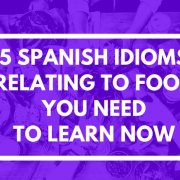What do people mean when they say Colombian Spanish?
The short and simple answer to this question is:
Colombian Spanish (“español colombiano”) is used more for geographical reference than linguistic relevance. It refers to various dialects of the Spanish language spoken in Colombia.
When people mention “Colombian Spanish,” they usually refer to the standard dialect spoken in Bogotá, which is generally known for being the clearest Spanish to understand and the easiest Spanish to learn.
Let’s explore what Colombian Spanish is and why it is so unique and attractive to new Spanish language learners.
In this article, we will talk about:
- The origins of Colombian Spanish
- Colombian accents and dialects
- The use of diminutive
- The use of the pronoun “You”
- Colombian slang
The origins of Colombian Spanish
Let’s start from the Beginning!
A bit of history and background is always interesting, right?
The Spanish language we know today is the result of thousands of years of language development and cultural influence. It emerged following years of invasion and settlement of many cultures in the Iberian Peninsula.
It all started with Castilian Spanish. It originated as a continuation of spoken Latin (Vulgar Latin) in Spain’s northern and central areas back in pre-colonial times.
Later, the northern dialect spread to the south, where it absorbed and blended with local Romance dialects (i.e., Judaeo-Spanish or Ladino) and borrowed many words from Andalusian Arabic.
And then, the colonization and “hispanización” period of the Americas back in the 15th Century.
Cultural Tip: “Hispanización” refers to the process of bringing the Spanish language and Spanish traditions, including the Catholic religion, into the Americas.
The Spaniards occupied the territory for over three centuries. Despite the efforts of the Spaniards to impose the language, many of the native local words were adopted since Castilian Spanish words were not accurate to the description of the many discoveries of the region.
Children and adolescents grew up, and the Spanish language spread and expanded in the region.
Latin American Spanish and its many dialects, including Colombian Spanish, emerged.
If you like history and want to deepen your knowledge of the origins of the Spanish language, go and read this article: “The Spanish language: history, evolution, and influences.”
Colombian accents and dialects
We just mentioned that Colombian Spanish is a group of dialects of Spanish spoken in Colombia.
So, how many dialects comprise Colombian Spanish?
There is a discussion between linguists regarding this topic.
Some say four, others say seven, and others even say Colombian Spanish is divided into eleven dialects.
Here are the eleven main dialects:
- Insular: spoken in the Islands of San Andrés, Providencia, and Santa Catalina.
- Costeño: spoken in the Caribbean Region.
- Santandereano: spoken in Santander and Norte de Santander Departments.
- Paisa: spoken in the departments of Antioquia, Caldas, Risaralda and Quindío.
- Chocoano: spoken throughout the Pacific coast.
- Cundiboyacense: spoken in the departments of Cundinamarca and Boyacá
- Rolo, or Bogotano: spoken in Colombia’s capital city, Bogotá.
- Opita: spoken in the departments of Tolima and Huila.
- Llanero: spoken in the Meta, Casanare, Arauca, and Vichada departments.
- Valluno: spoken in the valley of the Cauca River. Within this dialect, there is also Caleño dialect (specifically from the city of Cali).
- Pastuso: spoken in the southwest of the country in the Nariño department.
If you are curious about these regions and what are the main characteristics of these accents, read this article: Colombian Spanish accents: what you need to know.
What do those dialects sound like?
Although all these dialects sound similar to outsiders, they sound like “Colombian accent”; we, Colombians, clearly recognize the different accents depending on the region.
You will find some dialects that have an easier accent than others, such as others that use different pronouns when referring to the pronoun “you” in English.
Do they all have a different accent?
Yes!
If you want to hear how exactly they sound, go check this article “Getting used to the different Colombian accents.”
3. The use of diminutives
Something that makes Colombian Spanish unique and different from other types of Spanish is the everyday use of diminutives.
For some people, Colombians might overuse diminutives, but diminutives are a way of expression.
We use diminutives:
To emphasize that something is small or young.
Awm, !¡Mira que tierno ese perrito!
(Awm, look how cute is this puppy)
To express endearment, regardless of if the subject is small or young
Te presento a mi hermanita*
Let me introduce you to my “little” sister*
*Your sister could be an adult
To express endearment by adding the diminutive to People’s name
Dianita, Camilito, Andreita
To speak in a not-so-direct way.
¿Estás manejando como rapidito, no?
– You’re driving a little fast, aren’t you?
Diminutives can be applied basically to everything. However, it would help if you were very careful not to overuse diminutives in a sentence; it could sound annoying. It’s up to the person’s way of talking.
Diminutives can be added to nouns, adjectives, verbs, adverbs, and even prepositions.
It is an exciting topic that deserves an entire article. Stay tuned for it!
4. The use of the pronoun “You”
There are three ways of saying “you” (singular) in Colombia:
Tú eres: You are (singular, informal)
Vos sos: You are (Singular, informal)
Usted es: You are (Singular, formal)
These are used depending on the region.
For example:
- Paisas and caleños generally use “vos” for informal conversations.
- Rolos generally use “tu” for informal conversations, but between men, they usually use “usted” even with close friends
- Santandereanos generally use “usted” even with close friends
And, there is only one way of saying “you” in plural. Different to Spain we never use the pronoun “Vosotros”:
- Ustedes son: You are (Plural, informal and formal)
5. Colombian Slang
It is said that each language is the x-ray of a culture. Do you also agree?
For educational and professional purposes, Colombians, especially people from Bogota, make excellent and proper use of the language.
According to many new Spanish speakers, that “standard” Colombian Spanish is one of the easiest to understand and one of the clearest Spanish.
However, once you leave the capital and formal conversations, things start to get messy for new Spanish learners.
Colombians love making jokes and double-sense comments. We love using slang and popular expressions regularly.
We could write a book or make a dictionary of Colombian slang and popular expressions. But for the moment, we have been writing the most used and important ones.
Go check the following articles and start mastering your Colombian Spanish!
- 20 slang expressions we only use in Colombia
- 30 Colombian slang and what they mean
- 20 funny Colombian expressions and what they mean
We hope you have enjoyed this article as much as we enjoyed writing it!
If you want to improve your Spanish and learn more about Colombian Culture, drop us a line!
We will be happy to tailor a specific program for you!
And, don’t forget to follow our social media and read our bi-weekly blog to LEARN MORE THAN SPANISH.
We hope to see you in Colombia soon!












